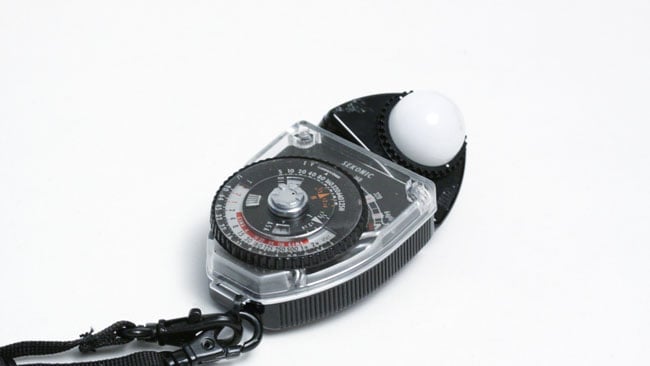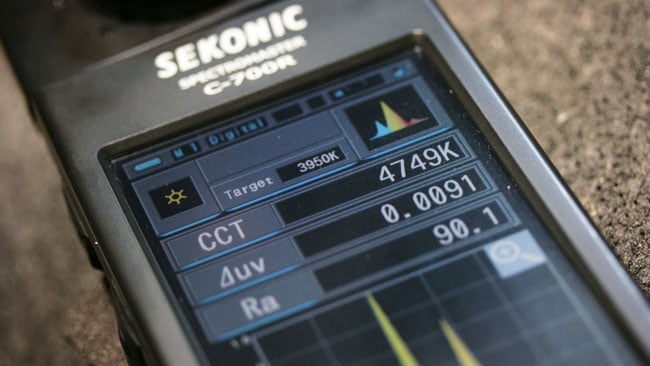Replay: The apparent convenience of shooting digital has meant that the humble light meter has taken a bit of a popularity hit of late. But as Phil Rhodes writes, they are in fact still one of the most valuable tools in the bag.
Quite often, one might find oneself asking “How much light is there in that place?”
“Oh,” says someone else. “You'll be fine. The ceiling was full of fluorescents.”
“Fine,” one replies. “Any idea how much?”
There's a pause.
“It looked bright.”
This instinctively seems a trifle inadequate. It is inadequate. Yes, I know you've got a histogram on the camera and yes, I know that a 4K camera is effectively 9 million colour-specific spot meters, but you still need a light meter and no, not because wandering around with one on the set looks cool.
As evidence for the problem, let's consider the fact that people are routinely overlooking 575W and 2.5kW HMIs for LEDs of less than 20% the power because they haven't ever put a light meter in front of the LEDs and noticed that the little needle doesn't go nearly as far around the scale as it did for the HMI. People trust their eyes. They trust the sensitivity of modern cameras to get them out of a jam and they shouldn't. The human eye is a miraculous instrument, but its ability to deal with extremes of contrast is precisely the problem. It's no kind of precision reference and the astonishing changes in light level that a meter will report can be a rude awakening to some people.
But there are yet other reasons why you need a light meter.

Sekonic's well-known L398 is primitive but informative
Your camera isn't a good light meter
First, even if you have your DSLR with you, you're stuffed. You can't get any information out of a DSLR's auto-exposure meter unless you're shooting a scene which happens to coincide precisely with the conceit that the average scene has a reflectance of 18% grey. That's what the auto-exposure behaviour of most cameras is designed to aim for, give or take a given manufacturer's specific tweaks and fiddles. If the scene doesn't have that reflectance, the exposure it recommends will be wrong. You can, if you like, carry around an 18% grey card and aim the DSLR at it and you will have carefully created the world's bulkiest, most power-hungry and most expensive light meter.
Conversely, there can be few tools which are as low-impact as a Sekonic L398 (currently £184 from Park Cameras.) It's pocket-sized, runs off the light it's measuring and handles calculations and range selection in an agreeably analogue, low-tech manner. It doesn't deal well with very low light levels but the calculation of F-stop and ISO against the absolute level of light is performed using rotating discs — a whiz wheel — which itself both teaches exposure as a concept and makes it clear how things will change with different settings for ISO. Most importantly, though, it'll tell you whether — when the director assured you that fluorescent-lit office had “plenty of light” — he or she was anywhere near the mark.

The C700R colour meter is alarmingly expensive and actually lacks conventional light meter features, but its lux readout can serve the same purpose
If you need any more reasons to own a meter, let's consider the traditional applications. No, not deciding where to put the iris on the camera, because that's something that really is better done by reference to a waveform monitor, as it will always be a more accurate reflection of the camera than a third-party device like a meter. Theoretically, you can do most of the things you can do with a meter using a waveform, at least if you get someone to wave a hand in front of the object of interest, but in practice it's much easier to communicate with someone who is (for instance) helping rig lighting if there's a quick, easy, mutually-understood way to figure out how bright that lighting is.
This is something that quickly becomes an issue on all but the smallest shows, for instance where there are concerns over creating consistent effects with various type of equipment in different circumstances. This is especially true with productions that return to locations more than once, or which need to visually connect two different locations, or which simply want to maintain some sort of visual consistency throughout. Which is most of them, surely?
Meters are a crucial tool for research, setup and consistency. Anybody can light one simple headshot, alone, using owned equipment, in a known location. Hollywood gloss is easy then. Scale things up even a tiny bit, and it quickly becomes necessary to be more specific about what we're doing.